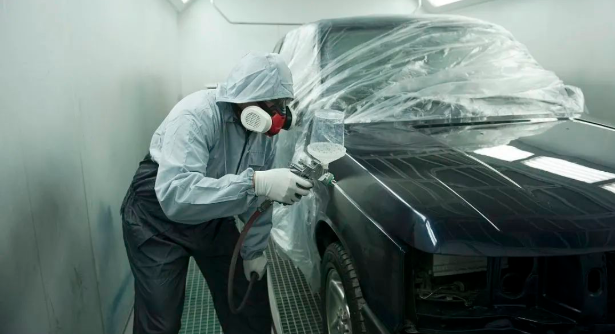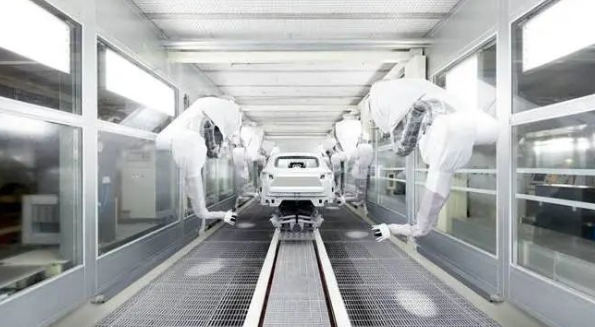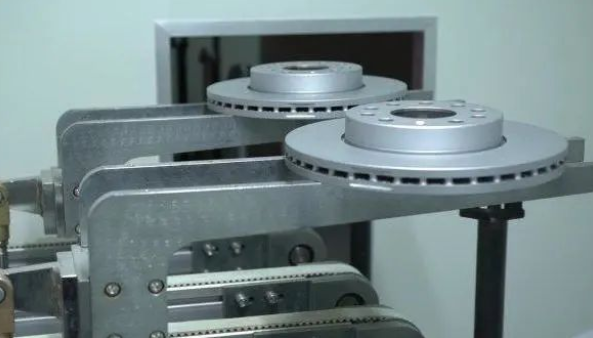
With the promulgation and implementation of increasingly stringent national environmental regulations, the requirements for automobile painting construction are becoming higher and higher. Painting should not only ensure good anti-corrosion performance, high decorative performance, and high construction performance, but also adopt materials and processes with good performance and reduce volatile organic compounds (VOC) emissions. Water-based paints are gradually becoming the mainstay of coatings because of their environmentally friendly components.
Water-based paints not only can effectively improve the efficiency of maintenance, but also have strong covering ability, which can reduce the number of layers of spraying and the amount of paint used, and can reduce spraying time and spraying costs.
Differences between water-based and oil-based paints
1. Different diluting agentsThe diluting agent of water-based paint is water, which should be added at different ratios from 0 to 100% depending on the need, and the diluting agent of oil-based paint is organic solvent.
2. Different environmental performanceWater, the diluting agent of water-based paint, does not contain benzene, toluene, xylene, formaldehyde, free TDI toxic heavy metals and other harmful carcinogenic substances, and therefore is safe for human health.Banana water, xylene and other chemicals are often used as the diluting agent of oil-based paints, which contain large amounts of benzene and other harmful carcinogens.
3. Different functionsWater-based paint not only does not pollute the environment, but also has a rich paint film, which is crystal clear after acting on the surface of the object and has excellent flexibility and resistance to water, abrasion, aging and yellowing.

Technical characteristics of water-based paint spraying
The volatilization of water in water-based paint is mainly controlled by adjusting the temperature and humidity of the spraying room, with the coating solids usually being 20%-30%, while the coating solids of solvent-based paint are as high as 60%-70%, so the smoothness of water-based paint is better. However, it needs to be heated and flash-dried, otherwise it is easy to have quality problems such as hanging and bubbles.
1. Technical characteristics of equipmentFirst, the corrosiveness of water is greater than that of solvents, so the circulating water treatment system of the spraying room needs to be made of stainless steel; second, the air flow condition of the spraying room should be good, and the wind speed should be controlled between 0.2~0.6m/s.
Or the air flow volume reaches 28,000m3/h, which can be met in normal baking paint room. And the drying room due to the high moisture content in the air will also cause corrosion to the equipment, so the drying room wall also needs to be made of anti-corrosion materials.
2. Automatic spray coating systemThe optimal temperature of the spraying room for water-based paint spraying is 20~26 ℃, and the optimal relative humidity is 60~75%. The allowable temperature is 20~32 ℃, and the allowable relative humidity is 50~80%.
Therefore, there must be proper temperature and humidity regulating devices in the spraying room. Temperature and humidity can be regulated in the spraying room of domestic auto painting in winter, but temperature or humidity can hardly be regulated in summer, for the cooling capacity is too large in summer.
In high temperature and high humidity areas, you must install central air conditioner in the spraying room before using water-based coatings, and cold air must be delivered in summer so as to ensure the construction quality of water-based paint.
3. Other equipment
(1) Water-based paint spray gunIn general, water-based paint spray guns with high volume and low pressure technology (HVLP) are used. One of the features of HVLP is the high air volume, which is usually 430 L/min, so the drying speed of water-based paint can be increased.
HVLP guns with high air volume but low atomization (15μm), when used in dry climates, will dry too fast and make the water-based paint flow poorly. Therefore, only a medium-pressure and medium-volume gun with high atomization (1μpm) will give a better overall effect.
In fact, the drying speed of water-based paint means nothing for car owners, and what they can see is the leveling, gloss and color of the paint. Therefore, when spraying water-based paint, you should not just search for speed, but should pay more attention to the overall performance of the water-based paint, so as to satisfy the car owner.
(2) Water-based paint blowing gun
Some sprayers feel in practice that water-based paint is slow to dry compared to solvent-based paint, especially in the summer. This is because solvent-based paints evaporate faster and dry easily in summer, while water-based coatings are not so sensitive to temperature. The average flash drying time of water-based paint (5-8 min) is actually less than that of solvent-based paint.
A blow gun is of course essential, which is a tool to dry water-based paint manually after it has been sprayed. Most of the mainstream water-based paint blow guns on the market today increase air volume through the venturi effect.
(3) Compressed air filtration equipment
Unfiltered compressed air contains oil, water, dust and other contaminants, which are very harmful to water-based paint spraying operations and can cause a variety of quality defects in paint films, as well as possible fluctuations in compressed air pressure and volume. Rework due to compressed air quality problems not only increases labor and material costs, but also hinders other operations.

Construction precautions for water-based paints
1. Little organic solvent allows the water-based paint not to react with the substrate, and its diluting agent water increases the flash dry time. Water spraying causes the water to easily drop at too thick side seams, so you should not spray too thick for the first time!
2. The ratio of water-based paint is 10:1, and only 10g of water-based diluting agent is added to 100g of water-based paint can ensure strong water-based paint coverage!
3. Oil should be removed by oil-based degreaser prior to spray painting, and water-based degreaser should be used to wipe and spray, which is quite important, for it can greatly reduce the chances of problems!
4. A special funnel and special dust cloth should be used for filtering water-based coatings.
 source: https://www.junhetec.com/news/water-based-coatings-applied-in-automobile-painting-2/
source: https://www.junhetec.com/news/water-based-coatings-applied-in-automobile-painting-2/Media Contact
Company Name: Changzhou Junhe Technology Stock Co., Ltd.
Email: Send Email
Phone: +86 13915018025
Country: China
Website: https://www.junhetec.com/